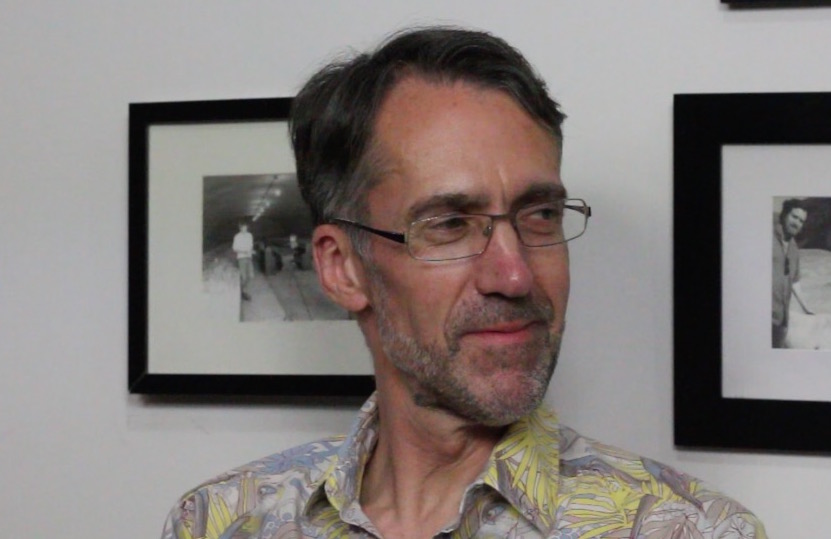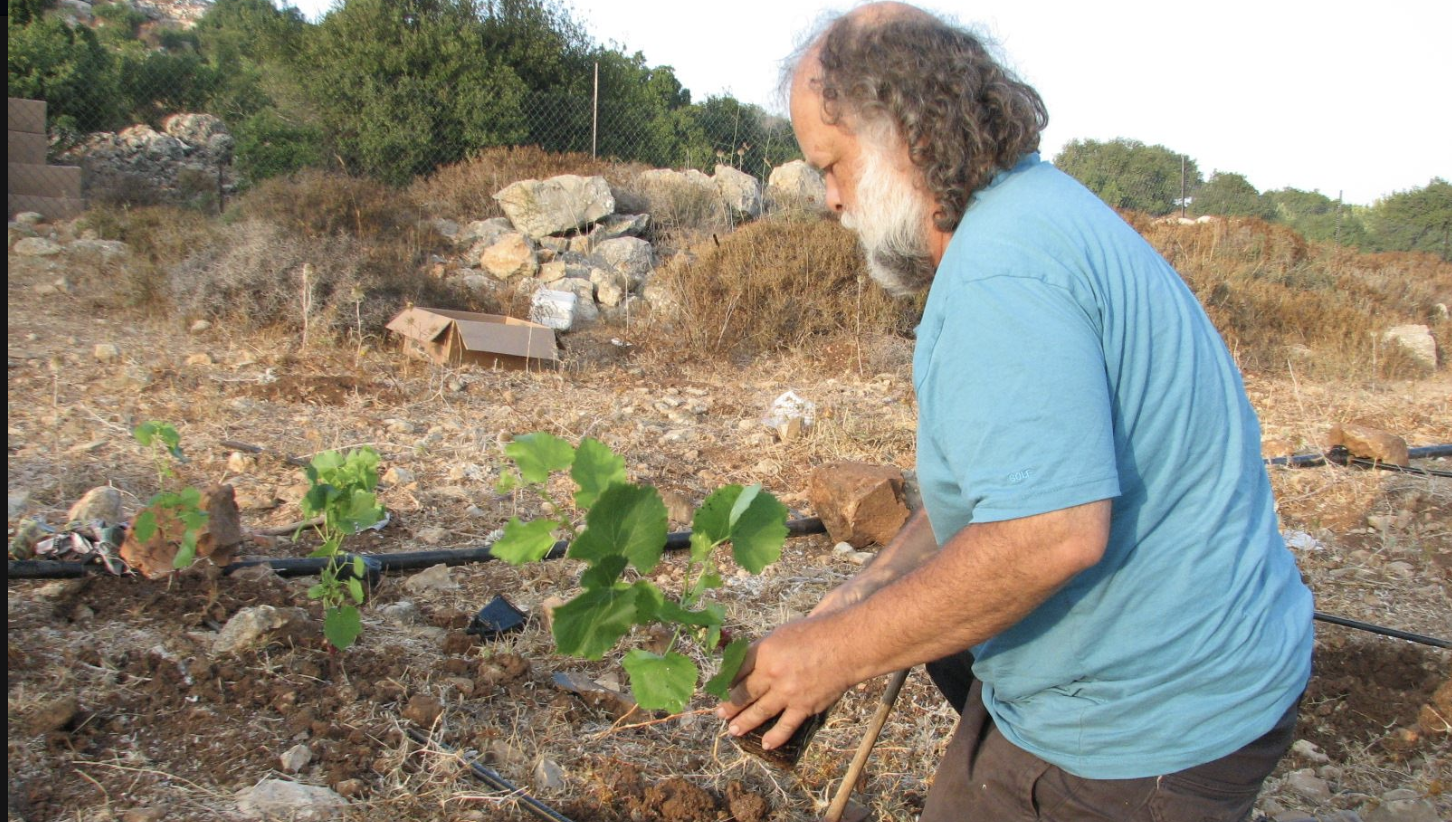
I can’t help it, but as we speed away from Tel Aviv Airport in Ze’ev Dunie’s white Toyota pickup, the owner-winemaker of Seahorse Winery in the Judean Hills reminds me of an Old Testament prophet. His wispy silver hair and beard glinting in the spring sunshine, his stocky build, deeply furrowed brow and earnest yet compassionate expression look like the prophets in the schoolbooks of Bible stories I read as a child back in 1960s England.
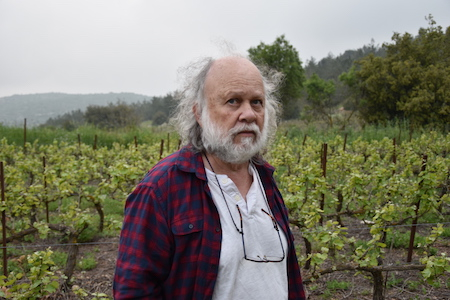
“It was the section about fermentation that did it for me,” he explains, “they were talking about bread and I suddenly realized that not only does bread not make itself, but wine doesn’t either. You need to do this!” Although we are in dense fast-moving traffic on a major highway he takes both hands off the wheel and claps them together forcefully. He was acting out the crushing or pressing grapes. Without exerting force on the grapes at some point you don’t get wine, because the yeast on the outside of the grape has to get at the sugar which is inside the berries for fermentation to start. And that means, they have to be broken.
“And that’s a manipulation!” shoots from my mouth.
“Exactly! Top winemakers talk a lot about non-manipulative handing of grapes and wine, but at certain points we are all manipulating!” Ze’ev concludes. Of course, that’s not the sort of thing the Old Testament prophets talked about in my schoolbooks and Ze’ev is not like them, in fact he doesn’t even produce Kosher wine! But who the hell is he?
“If I was asked to describe this year, then I would say that it was about more and more questions,” he explains as we turn off the highway and start climbing a narrow road that twists and turns through pine trees, gorse, wild herbs and white limestone rocks. “This is where the Judean Hills really begin,” he continues, “Seahorse and our vineyard are both 700 meters above sea level and up it’s often 4° to 5° centigrade cooler there than in Tel Aviv down on the coast.” That’s the main reason these hilltop vineyards are capable of giving exciting wines at 31° 30’ North, but this is only one of the basic facts of this Mediterranean type climate that I’m still trying to figure out.
I met Ze’ev during my first trip to Israel in October 2014 when I visited his delightfully improvised winery and I’ve travelled here again because of an extraordinary blind tasting Ze’ev staged at the Edel & Faul alternative wine location in Berlin in May 2018. Usually that kind of blind tasting is all about a New World winemaker showing that his expensive Bordeaux-style red bland can stand up against the yet more expensive First Growths from Bordeaux itself, according to the motto; eat my dust, Lafite! Ze’ev’s tasting was composed of 7 vintages of his Antoine, one of the first Rhône style reds from Israel, and the other half was a Chateauneuf du Pape from each of the same 7 vintages. Nobody present could remember anything like it.
“It’s an experiment,” said Ze’ev, “let’s see what happens.” If something gave away some of the French wines it was funk and a couple of the participants used that to try and always prefer the French wines. Why not if you like the smell of Band-Aid? In spite of that, all 14 wines managed to balance serious body and robust power with enough black fruit, spicy aromas and freshness not to taste heavy or overwhelming. Although the very best wine was French – the ripe, yet super-elegant 2009 Reserve from Domaine Clos du Caillou – in the 2014, ’13 and ’12 vintages Antoine held its own against the Châteaueneuf du Pape (including famous names like Beaucastel and Pegau), and in the 2011 and ’08 vintages I preferred Antoine to the French wines. Notes of liquorice, dried lemon peel and soy sauce give Ze’ev’s Antoine a personality all its own. Finally, here was a blind tasting that really said something, rather than being just a red wine swimsuit contest.
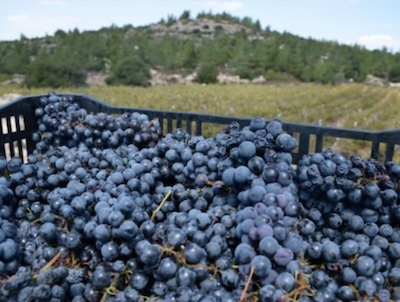 “Up to the 2012 vintage Antoine was a GSM – the standard abbreviation for red blends of the Grenache, Syrah and Mourvèdre grapes,” Ze’ev explained meaning that it had been a blend of this trio of Mediterranean red grapes. “Then I got lucky and a temporary softening of the import controls enabled me to bring Cinsault and Counoise vines into Israel. Those varieties are essential ingredients in the traditional Châteaunuef du Pape blend and they’re in every vintages of Antoine from 2013.”
“Up to the 2012 vintage Antoine was a GSM – the standard abbreviation for red blends of the Grenache, Syrah and Mourvèdre grapes,” Ze’ev explained meaning that it had been a blend of this trio of Mediterranean red grapes. “Then I got lucky and a temporary softening of the import controls enabled me to bring Cinsault and Counoise vines into Israel. Those varieties are essential ingredients in the traditional Châteaunuef du Pape blend and they’re in every vintages of Antoine from 2013.”
The interesting about all this is how it goes totally against the grain of the modern Israeli wine industry that only dates back to the 1990s. Most of Israeli winemakers are obsessed with carving out a reputation for making quality wines from the standard international varieties that are planted right around Planet Wine: Cabernet Sauvignon, Merlot, Chardonnay and Sauvignon Blanc. The Usual Suspects for well-made wines that lack a clear personality! Israeli winemaking styles for these grapes are usually modelled on California, because most of the winemakers trained at the UC Davis wine school. Consequently, there’s not enough easy drinking wine, nothing from Israeli giving the kind of refreshing jolt that Beaujolais, Riesling or Pinot Blanc so often does.
Surely there were other differences between the Israeli mainstream and what Ze’ev is doing, but to discover them I would have to return to Israel. So I went through all the security checks and suffered the cloud of suspicion that descended upon me when I stated the truth: “I’m a journalist”. After the El Al employees realized I was interested in wine rather than the Middle East Conflict they let me on the plane to Tel Aviv. When I got off it I ignored beautiful and sexy Tel Aviv and headed straight for Ze’ev’s pickup.
"This red is the story of three years!“ Ze’ev says to me with great emphasis. We’re sitting in the bustling Restaurant Salya in Jerusalem with his wife Orly, who looks more like an Indian queen than a Jewish princess. In front of each of us is a glass of red wine and the bottle they were just poured from. The label says 2014 Underground Kafka, and I can’t help thinking of Joseph K. the hapless antihero of Kafka’s The Trial. That’s hardly a cool association for a wine, although back in the early 1990s I once got into the Limelight night club in NYC by telling the doorkeeper I was Joseph K. It’s extreme stuff with aromas ranging from summer flowers to dried black olives, the flavours bold and rich with just a hint of sweetness, but it’s got an absurdly lively aftertaste considering all the thunder rolling around in it. So, maybe Kafka’s a good fit?
"In the late summer of 2014 the Petite Sirah grapes for this wine finally came in from the Galilee region. Jewish and Muslim holidays had delayed the harvest by 10 days, then the grower told me the grapes were raisins! They had over 30 degrees Brix, but the pH was very low, 2.95. It tasted like an energy drink!” Those numbers speak of an extreme combination of super-ripeness and super-tartness for a red wine, and the energy drink description gives a rather good idea of how it tastes.
I remember those Petit Sirah grapes, because the first time I visited Seahorse was the day after they arrived at the winery and the darkest of the innumerable purple stains on the winery floor result from their crushing. Back then Ze’ev told me that the wine would, “either be terrible or genius!”
“The fermentation got stuck while it still had some unfermented sweetness, so I re-fermented it a year later by adding fresh juice, but then it was a monster. It was so heavy it pulled you down! So I added some Mourvèdre and Grenache red wine to lighten it up. It’s like a patient brought into the hospital in such a bad shape that all the doctors say there’s nothing they can do for him, except for one who says let me try something, then it actually works!
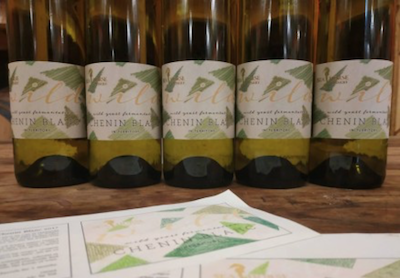 "So it’s good that I didn’t come back sooner, because now it lifts me up,“ I say. Then Ze’ev pours us all the 2017 “Wild” Chenin Blanc, made from grapes from his own vineyard high up in the Judean Hills that was wild-fermented, i.e. meaning no yeast from a packet was added. I love the flinty note and the interplay of saltiness and the lemony acidity. It’s fascinating and refreshing now, but I’m pretty sure that it will also be good in another five to ten years; a rarity for an Israeli whites, which mostly need to be drunk on release.
"So it’s good that I didn’t come back sooner, because now it lifts me up,“ I say. Then Ze’ev pours us all the 2017 “Wild” Chenin Blanc, made from grapes from his own vineyard high up in the Judean Hills that was wild-fermented, i.e. meaning no yeast from a packet was added. I love the flinty note and the interplay of saltiness and the lemony acidity. It’s fascinating and refreshing now, but I’m pretty sure that it will also be good in another five to ten years; a rarity for an Israeli whites, which mostly need to be drunk on release.
"People talk about the influence of oak on wine, but actually yeast is the biggest influence on the flavour of wine in the cellar,“ he continues. And from there he proceeds to the importance of fermentation yeast bio-diversity for developing complex wine flavours. It sounds technical, but basically the healthiest eco-systems are the ones with great bio-diversity and a tank of fermenting wine is an eco-system that can be one-dimensional or richly diverse. The results of each generally taste the way you’d expect, in the former case often banal and in the later frequently tantalizing.
"I’m convinced that all the great cultural things also come about through synergy, through cultures mingling freely,“ I add.
“I’m half Czech Republic and half Lithuanian,” Ze’ev explains, “my father grew up in Berlin and left at the last possible moment.”
“My parents came from India and Iraq,” Orly says, “those kind of combinations are rather common here in Israel.” The complexity of Israel’s Jewish population – Ashkenazi, Sephardic, Russian, Ethiopian and Yemeni, just to name the main groups – and the often tense relationships between them are not well-known in the West.
It’s after midnight as we leave and Ze’ev insists on driving to the Jerusalem YMCA, which sounds like nuts sightseeing or a complete wild goose chase. It stands opposite the famous King David Hotel that was the scene of a Jewish terrorist bombing in 1947 at the end of the British Protectorate, meaning when Palestine was a de facto British colony. The King David is a bulky limestone sarcophagus in which you could bury a handful of pharaohs. Then I turn around and there’s the soaring tower of the YMCA. It reminds me of the bell tower in Hitchcock’s hypnotic movie Vertigo, although its much higher and more crazy. “My grandfather’s construction company built this in the early 1930s,” Ze’ev says. Now he’s building his own crazy towers of wine.
The next day we taste a lot wines with leading Israeli wine critic, Itay Gleitman. It’s really interesting and comparing Ze’ev’s own wines with a wide selection of other Israeli wines, plus some French and Californian “originals”. However, it doesn’t really help me to figure out this guy. Rather, it confirms Ze’ev is daring to do many things differently from most of his colleagues and the resulting wines age really well. But where did all this come from?
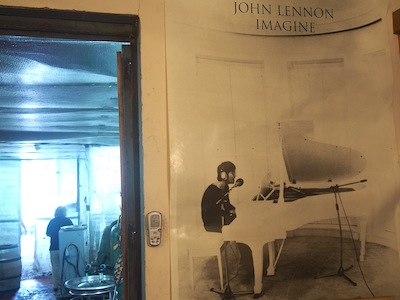
The weather had been beautiful from the moment I arrived, the lush and green Judean Hills bathed in sunlight that made it hard to imagine they are part of a land locked in a seemingly intractable and brutal conflict. But when it’s finally time to visit the vineyards suddenly the sky is grey, the Judean Hills clouded in mist with drizzle in the air. The backgrounds of those pictures of those Old Testament prophets in my schoolbooks never looked like either of the two versions of the Holy Land that I’m seeing.
“I have 7.5 acres here, plus half an acre right next to the winery and another 3 acres in Galilee,” Ze’ev explains as his pickup bounces along a dirt track, “they are planted in ancient fields each of which is half an acre in size. The soil is a thin layer of terra rosa clay over the limestone base of the Judean Hills. Here I have Chenin Blanc, Grenache, Syrah and Zinfandel.” The low stone walls separating the vineyards are probably just linear piles of rocks that were pushed to the side to make cultivation possible. I’ve seen that in many countries and climate zones.
We stop and get out to take a closer look at the vines, which have just budded out. Although they’re planted in rows they have chaotic shapes not quite like anything I’ve ever seen before, so they certainly weren’t pruned in the conventional way. Many of the world’s great wines come from impeccably neat vineyards, but I’ve seen a number of eccentric cultivation systems that broke all the rules and worked extremely well. This looks to be another of them. There’s also more “weeds” growing between the vines than in most vineyards I saw in Israel, so the soil hasn’t been pumped full of herbicides.
“Mid-growing season this becomes a jungle and the only people who can handle it are the Palestinians who work for me! Each morning around 5pm they call me after getting through the checkpoint at the border to the West Bank, then I go and pick them up. They do six hours of work here, I pay them in cash and take them back to the checkpoint. Seahorse wouldn’t function without them!” Suddenly there’s the Middle East Conflict, but also another of the many tales of Israeli-Palestinian co-operation I heard or experienced first hand. Here’s the Israel story the international media rarely even begins to tell.
Standing in the vineyard trying to take a photo of Ze’ev that does justice to him I feel cold and wet in this famously hot and dry land. Then, suddenly, it hits me. All of these things – the crazy vineyards, the many forms of bio-diversity and cultural synergy – interlock with this beautiful and strange piece of land to create those delicious and fascinating wines and this man who’s the point where that happens really is some kind of winemaking prophet!
Stuart Pigott is a British wine journalist living in Berlin. He has published a number of other wine books, including Touring in Wine Country, the Wine Atlas of Germany, Planet Wine, and Life Beyond Liebfraumilch.
Buy Stuart Pigott's The Best White Wine on Earth: The Riesling Story on Amazon for $17.30.
Buy Stuart Pigott's Kindle book ROCK STARS OF WINE AMERICA #3: FLXtra with KJR - This is a Love Story on Amazon for $4.99.
More from Stuart Pigott on Grape Collective:
Read Part I of the series: The Rise of The Hipster Sommelier
Read Part II: The Rise of the Hipster Sommelier Part II
Read Part III: Rise of the Hipster Sommerlier Part III
Read BDX Pt. 1
Read BDX Pt. 2
Read BDX Pt. 3 New Bordeaux, Money Secrets and Michel Rolland
